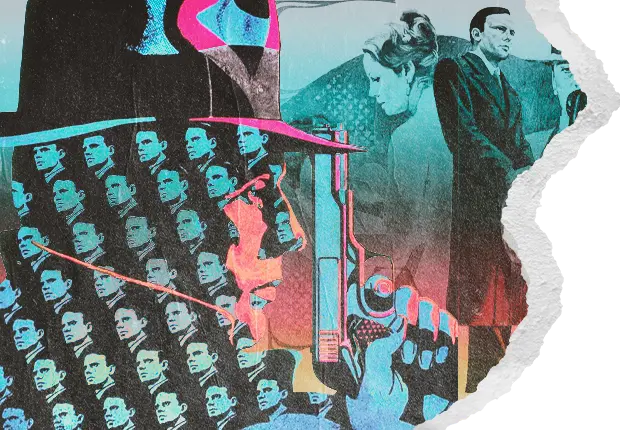The Conformist
When Americans think of Italian cinema, the first thing that usually comes to mind is the Spaghetti Westerns of the 1960s. While these films injected American culture into Italy, Italian filmmaking was at the same time undergoing a shift in its own stylistic and thematic character, one that is reflected in the broader popular culture of the West today. No film is more representative of this transformation than Bernardo Bertolucci’s Il Conformista (1971), newly re-released in 4K.
The 1950s saw the emergence of Italian neorealism, a political movement in cinema that sought to portray the struggles of ordinary citizens. These films depicted the daily lives of the Italian working class, employing non-actors and shooting on location in the rubble of post-war Italy. Classics of this era include Fellini’s La Strada, De Sica’s Bicycle Thief, and Rosselini’s Rome, Open City. Although the films are sympathetic to Marxist ideas, it’s not accurate to call them Marxist films. They largely dealt with materialist concerns and certainly had a lot to say about the plight of the lower classes, but did not aim for outright political agitation in the way true communist films did at the time. The goal was to spotlight the downtrodden in a realistic manner, not push them toward revolution. The films sought truth. They were still art.
In the 1960s came experimental surrealism—the director as auteur. Conversely, these films were typically less political but more revolutionary, at least in their aesthetics. Characterized by non-linear narratives and dreamlike editing, they explored the subconscious by blurring the line—both stylistically and thematically—between reality and fantasy. While surrealistic directors were certainly politically engaged—as they were often the same directors at the vanguard of neorealism a decade earlier—their films explored more introspective themes: the subjective nature of reality, the search for meaning in modernity. They focused on rebellion, not as a political act but as art. Classics of this era such as Fellini’s 8 ½ and La Dolce Vita focused less on the artist as a locus of political change, but the role of an artist as an individual and observer. Despite reflecting the explosive decadence of a recovering Italy, they still sought the truth of the human condition and remain the high point of Italian cinema.
Yet the 1970s saw the commercialization and radicalization of both movements. A new era of radical filmmakers, including Bertolucci, synthesized artistic experimentation and sociopolitical critique, giving birth to a new era of ideological filmmaking. Films of the 1970s reflected the sensibilities of the New Left, but by necessity had to appeal to an increasingly homogenous, consumer-driven Italian society. They were revolutionary in that they personalized the political, dealing less with materialist class conflict and more with suppression of sexuality and gender by established tradition. Yet at the same time they were insufficiently political, at least from a classical Marxist perspective, in that they accepted the intrinsic value of beauty—a hangover from surrealism. Like neorealism, these films examined ordinary people, but did so from the heights of self-critical bourgeois affluence. To be “ordinary” was to be an individualistic bundle of suppressed desires, content with small joys, distracted by petty ambitions, and blissfully unaware of the slog of modern life—until the repression all explodes at once. The result: beautifully crafted films, molding traditional and radical themes to broad appeal, and insidiously pushing an agenda whose effects we are now only too familiar with.
Bertolucci, who died in 2018, was a pioneer of this style of filmmaking. Probably gay, he was himself a bundle of suppressed desires, as well as a child of bourgeois affluence whose redisocovered consciousness led him to believe he had a special authority to critique. After becoming disillusioned with the student movements of May 68, he re-evaluated the capability of film to enact revolutionary change and instead pursued a “dialectic relationship” with mainstream audiences. Il Conformista is one of the earliest—and best—examples of this tradition. On the one hand, it is a beautifully shot blockbuster, a spy thriller, a love story, and tragedy in the truest sense as our hero’s conformity to societal expectations results in him killing the one woman he ever loved. On the other, it is a radical critique of the type of person who is driven to pursue a life deemed “normal.”
“What do you think marriage will get you?” a voice asks off screen to first introduce our hero.
“Well, the impression of normality.”
The film follows Marcello Clerici as he falls headfirst into the Fascist Party of 1930s Italy. He is the classic male archetype—young, successful, generationally wealthy, intelligent, and handsome, but just below the surface he is diabolical, scheming, insecure and desperate. Bertolucci posits that this is a natural dialectic battling within the soul of what “normal” people would consider an ideal specimen—the combination of which leads to his compulsive pursuit of normality. Flashbacks reveal that a homosexual dalliance in his youth ends in murder. Is it pedophilic rape? Is it unrestrained eros? Did it even happen at all? We’re not quite sure, but it is the source of the trauma that creates a repetition compulsion—an unconscious tendency to repeat a traumatic event—in the damaged man.
Marcello’s personal life all compounds into his decision to join the Party. He is torn apart by his sexual desires and has nothing but disdain for his pointedly abnormal parents: his decrepit, aristocratic mother and his syphilitically-insane father. Yet he has equal contempt for the painfully trite “petty bourgeois” he intends to marry. She’s “all bed and kitchen,” but at least a dull marriage will fulfill his craving for stability and security.
And this is what leads him to join the party. It’s clearly not fear, money or faith in fascism, a Colonel contends in his induction interview, so “I must ask myself what your aim is?” “I stand prepared to go as soon as you decide,” is all Marcello can placidly muster. Marital and Party allegiance is what Bertolucci believes society demands of a normal man.
On its stylistic merits alone, the film is a masterpiece. Bright blues and reds illuminate guilt and innocence. Wide shots in Rome’s EUR district capture the oppressive magnificence of fascist architecture while distorted camera angles (cheesy now, but decades ahead of their time) suggest the perversion of a society where this is all considered normal. It is paced suspensefully through a series of dreamlike flashbacks–often misremembered—a Freudian probe into Marcello’s subconscious that drives both his actions and the plot of the film. The film’s artistic experimentation reflects an abiding surrealism, but the core social push and architectural emphasis grounds it in neorealism—all wrapped into a blockbuster smash.
While the combination of styles works cinematically, it makes the film thematically jumbled. The film is acutely political but lacks a cohesive political theory. On the one hand, Bertolucci was well known as a self-pronounced Communist. He has stated that the film is primarily meant to be a critique of bourgeois life, but his clear fascination with emotion, artistry, and even romanticism in the film belies his Marxist sensibilities. This focus is no incisive critique. He is infatuated with his own artistic innovations as well as the decadence in architecture, fashion, and art of 1930s Italy and France. This is reflected in Marcello’s own infatuation with the wife of the man he is tasked to kill: a decidedly abnormal libertine who seduces both Marcello and his wife.
Upon joining the Party, Marcello is sent on a mission to assassinate his former Classics professor, now an exiled left-wing intellectual in Paris. In a transparent metaphor, he brings along his wife so that the honeymoon may serve as cover. This scheme makes up the central action of the film.
Marcello, once a star pupil, infiltrates the professor’s dissident circle. They speak of Plato’s cave, and freed from the shadows, Marcello is once again enamored by what Bertolucci believes to be a life of liberation and fulfillment. Mostly, he is smitten by the professor’s bisexual wife, a free spirit in the most Nietzchean sense of the term. He is torn. Complete the mission and secure “normality” at home, or flee and embrace his deepest desires?
No longer the “the people” of a Marxist imagination, these are the “real people” as Bertolucci’s New Left sees them: individuals composed entirely of repressed desires, who can only be pushed so far until they explode. Marcello’s self-repression ultimately leads him to set up the murder of the professor and, inadvertently, his wife who was not meant to be there during the attack. He watches on helplessly, his look of horror constrained only by the acceptance of his impotence.
Yet the violence Marcello inflicts is not his repressed desire coming out as aggression. The violence is the norm for this archetype—even an initiation rite into normality. The “average man is fascist,” Bertolucci explained in an interview about the film. “His subconscious will is to dominate others, but that only comes from the conscious acknowledgement that he is average.” The film is meant as a searing critique of bourgeois susceptibility to fascist propaganda because as individuals, they seek, like Marcello, to compensate for the subconscious inadequacy they feel in their own powerlessness and mediocrity.
It is only long after the murders, with the fall of Mussolini, that Marcello’s repression is unleashed in renunciation of fascism. In the final scene, he violently denounces both the Party and the murders, as his semblance of normality comes crashing down around him. It is only here that his repressed trauma finally bubbles out, as the film ends with him staring lustfully at a prostrated young boy down a back alley.
To Bertolucci, denouncing fascism is a corollary to rejecting normality. Embracing one’s desires means rejecting bourgeois sensibilities. While Bertolucci thinks Marcello is more a mold of oppressive society rather than an agent of free will, his actions are ultimately driven by subconscious, not false consciousness. Part Marx, part Freud—what the film lacks in coherent political theory it makes up for in rigid ideology. Average people, as represented by Bertolucci’s average characters, do not have a choice in their lives. The only true choice is to resist any and all convention, to reject “normality” in its entirety. Anything but liberation is subjugation. In a Freudian twist, even Marcello’s resistance ceases to be a conscious act: it is merely the libido inevitably breaking through.
Bertolucci is wrong to frame conformity as compulsion. Conformity is not passive. Like evil, it is a choice. Marcello knows what he is doing is wrong. In the opening scene, his friend—a fascist radio broadcaster—remarks his perplexity at Marcello’s desire to fit in, given that people usually try to stand out. Marcello responds by telling a story of how his father and his friends used to buy drinks for a man at a German bar to encourage his drunken speeches: “That was Hitler,” Marcello explains.
With this scene, Bertolucci intends to show the power of propaganda and how average people were willing to overlook Hitler’s dangerous ideas in order to conform to the dominant culture of the time. The dumb, drunken men in the bar are a microcosm of broader society.
Yet in delving into Marcello’s subconscious, Bertolucci inadvertently depicts his conscious acknowledgement of right and wrong. The “funny, nutty man” at the bar making the “wild speeches” was clearly not “normal”: he was the outlier in a bar full of presumably reasonable people. In this framing, Marcello is self-aware to an extent that the men at the bar perhaps were not. He tacitly acknowledges what Hitler said was wrong, but nevertheless uses the memory as justification to make the same choice as his father. Marcello, like most men, is able to see right and wrong for what it is. He is not a passive bystander in his own life, but a moral agent who consciously chose an immoral path in an equally conscious pursuit of normality.
What becomes clear watching the film today is that Bertolucci, like most in the West, has a severe blindspot for his own ideology. He believes he is above it all. The director auteur. Artistically, he alone is free to choose. Yet he is not truly the director of his own art. The ideology guides it at every turn. Seeking to create liberatory art, Bertolucci fails to see his own enslavement as his artistic conformity to the burgeoning movement around him is ironically less self-aware than his own character.
By equating bourgeois and fascist dispositions, Bertolucci blames the former for the rise of the latter. Socialist revolution, presumably, is his only solution. Yet this fails to take into account the similarly repressive nature of both regimes, which Bertolucci either fails or pretends not to see in his own art. It is not certain ideologies that lead us to conform: it is ideology itself.
Any iteration of rigid ideology leads to conformity, particularly in art. One need only look at the similar treatment of art by both the Soviets and the Nazis as they sought to control artistic expression for propaganda purposes. Both used art to glorify their ideologies and denounced art that did not conform. The Nazis’ infamous Degenerate Art Exhibit and the Soviets’ Decadent Art Exhibit denounced free spirited art in much the same terms. Art centered on the artist’s own vision and license was unacceptable because it posited a value higher than the demands of the ideology.
Ultimately, Bertolucci took a style that is true (neorealism) and a style that is beautiful (surrealism) and created something ugly and false. Il Conformista is as aesthetically pleasing as any film can be, but it cannot, as art, be beautiful because it subordinates truth to a base and disingenuous view of human nature. True art uplifts. False art enslaves.
So Marcello is in fact a deformed man, but not for the reasons that Bertolucci imagines. What Bertolucci means by “normal” is actually convention, only the rejection of which can lead, in his vision, to the good, natural, liberated “normal”—the tabula rasa human condition. These are two dialectical forms of “normality,” and Marcello’s pursuit of one and collapse into the other is a deep rejection of normality in the truest sense. A truly normal man, at all times and all places, is a product of both forces: our vitality drives us to action in pursuit of desire, our inculcation to convention checks our worst impulses, and our conscious will guides us to balance between them. This is the true “dialectic” by which civilizations rise and fall.
Some men are more responsive to one of these forces than the other, and far fewer can channel them optimally to achieve magnificent feats of greatness. Bertolucci, like the rest of the New Left, seems unable to form a well-adjusted conception of either force, so he subjects us all to pitiful, self-contradictory exhortations of his own inadequacy.
When the film was originally released, the ideological component was nascent and exhilarating. Today however, it has solidified into dogma for much of Western society, increasingly imposed from above by our ruling class and cultural arbiters. The true legacy of the film 50 years on is the length ideological filmmakers will go to in order to conceal their ideology both from themselves and their viewers.
Il Conformista is an early, albeit more refined, prototype of what is now the new “normal.” From awkwardly colorblind casting and injecting queerness into children’s movies, to rewriting and editing films for the “sensitivity” of “modern audiences,” Bertolucci’s “dialectic relationship” with audiences has become standard in Western cinema. Filmmakers claim to care about “authenticity” and “representation,” but depict nothing but politicized caricatures of the human experience. They are endowed with the most awesome filmmaking technology, but produce nothing but computer generated ugliness. This posture of revolutionary consciousness blends into a dehumanizing amalgam of gross commercialism, falseness, and ultimately conformity which nevertheless has been more successful than Bertolucci could ever have imagined in his wildest dreams. Our very idea of personhood, as shaped in large part by Hollywood over the last 50 years, is now reflected in Marcello.
The new conformity is not fascist. Perhaps things would be better if it were. Anything is better than conforming to the pious neuroses of weak, defective men like Bernardo Bertolucci.
































